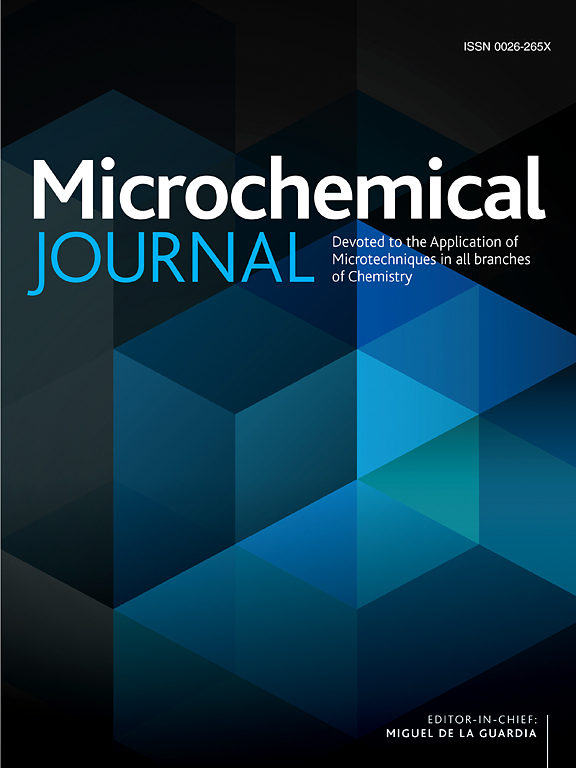Fan assisted extraction and low pressure chromatographic system with a phenyl monolithic column for amperometric determination of volatile α-dicarbonyl compounds in coffee brews
IF 4.9
2区 化学
Q1 CHEMISTRY, ANALYTICAL
引用次数: 0
Abstract
In this work, a low pressure chromatographic system featuring a single 0.5 cm length phenyl monolithic column and an amperometric detector was developed to determine volatile ⍺-dicarbonyl compounds in coffee brews. The analytical strategy relied on the extraction of the volatile ⍺-dicarbonyl compounds and their derivatization with o-phenylenediamine, prior to the determination of the resulting quinoxaline derivative compounds in the designed chromatographic system. The studies of the mobile phase composition and electrochemical conditions are presented. The extraction of the volatile ⍺-dicarbonyl compounds was performed resourcing to a recent approach based on the fan assisted extraction system. This system performs the full evaporation technique and allowed the quantitative recovery (>85 %) of diacetyl and 2,3-pentanedione from the coffee brew based on the following experimental conditions: sample volume 30 µL, extraction period 15 min, acceptor solution (water, acetonitrile, 90:10, v/v) volume 400 µL, and sample temperature 50 °C. The developed method showed no matrix effect for different coffee brews and the quantification of the studied analytes can be performed through the external calibration method. Detection limits of 3.6 × 10−6 mol/L for diacetyl and 12.9 × 10−6 mol/L for 2,3-pentanedione were obtained. Sample analysis rate was of 5 h−1 and the acetonitrile consumption was of ca. 450 µL per chromatographic run.

采用苯基整体柱的扇形辅助萃取和低压色谱系统,以安培法测定咖啡冲泡物中的挥发性 α-二羰基化合物
本研究开发了一种低压色谱系统,采用单根 0.5 厘米长的苯基整体柱和安培检测器,用于测定咖啡冲泡物中的挥发性⍺-二羰基化合物。分析策略依赖于萃取挥发性⍺-二羰基化合物并用邻苯二胺对其进行衍生化,然后在设计的色谱系统中测定由此产生的喹喔啉衍生物化合物。报告介绍了对流动相组成和电化学条件的研究。挥发性⍺-二羰基化合物的萃取采用了基于风扇辅助萃取系统的最新方法。该系统采用全蒸发技术,可从咖啡中定量回收(85%)双乙酰和 2,3-戊二酮,实验条件如下:样品体积 30 µL,萃取时间 15 分钟,接受溶液(水、乙腈,90:10,v/v)体积 400 µL,样品温度 50 °C。所开发的方法对不同的咖啡冲泡物没有基质效应,可通过外部校准法对所研究的分析物进行定量。双乙酰的检测限为 3.6 × 10-6 mol/L,2,3-戊二酮的检测限为 12.9 × 10-6 mol/L。样品分析速度为 5 h-1,每次色谱运行消耗乙腈约 450 µL。
本文章由计算机程序翻译,如有差异,请以英文原文为准。
求助全文
约1分钟内获得全文
求助全文
来源期刊

Microchemical Journal
化学-分析化学
CiteScore
8.70
自引率
8.30%
发文量
1131
审稿时长
1.9 months
期刊介绍:
The Microchemical Journal is a peer reviewed journal devoted to all aspects and phases of analytical chemistry and chemical analysis. The Microchemical Journal publishes articles which are at the forefront of modern analytical chemistry and cover innovations in the techniques to the finest possible limits. This includes fundamental aspects, instrumentation, new developments, innovative and novel methods and applications including environmental and clinical field.
Traditional classical analytical methods such as spectrophotometry and titrimetry as well as established instrumentation methods such as flame and graphite furnace atomic absorption spectrometry, gas chromatography, and modified glassy or carbon electrode electrochemical methods will be considered, provided they show significant improvements and novelty compared to the established methods.
 求助内容:
求助内容: 应助结果提醒方式:
应助结果提醒方式:


